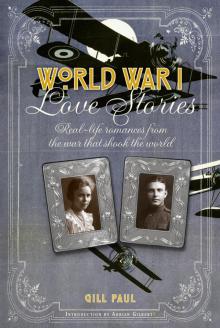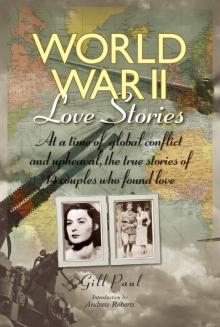World War II Love Stories Read online
WORLD
WAR II
Love Stories
At a time of global conflict and upheaval, the true stories of 14 couples who found love
Gill Paul
Introduction by
Andrew Roberts
September 1939 saw Adolf Hitler lead the world into one of the greatest conflicts the world had ever known. The atrocities unleashed by the Nazi regime were unprecedented: families were torn apart, millions were murdered, and a cloud of fear cast over the world. But throughout all this, love and hope remained ignited.
World War II Love Stories tells the unforgettable stories of those couples brought together by war. They are enduring tales of great love, intense passion, and often tragedy, but most of all they are tales that celebrate the human spirit at its time of greatest trial.
CONTENTS
Introduction
Coco Chanel & Hans von Dincklage
French fashion designer Coco Chanel’s affair with an aristocratic German attaché was fiercely controversial and led to her arrest at the war’s end.
William & Kathleen Anderson
William and Kathleen’s unyielding love for each other helped him to survive imprisonment in Colditz.
Bill & Norma Kay Moore
Romantic Bill went AWOL so he could spend his first wedding anniversary with his wife, Norma.
Desmond Paul & Louisa Henry
Desmond and Louisa’s love blossomed after a chance encounter, and this love would save his life on two occasions.
Étienne & Violette Szabo
Married barely a month after they met, Étienne and Violette tragically had very little time together.
Charley & Jean Paul
Charley and Jean’s deep love helped her to survive the tough realities of life on a Tobique reserve in the wilds of Canada.
Dwight D. Eisenhower & Kay Summersby
Despite his elevated position and a wife back home, Dwight clearly had strong feelings for Kay.
Roger & Rosemarie Williams
Roger and Rosemarie met in northern Germany as the Russian army approached and the Iron Curtain split her family in two.
Allen Dulles & Mary Bancroft
Mary’s affair with Allen, a spy, was unconventional, thrilling and potentially dangerous.
Hudson & Betty Turner
Betty wrote 300 letters to GI Hudson and always hoped he’d come back to marry her.
Bob & Rosie Norwalk
Bob was unhappily married and when he met cheerful, friendly Rosie he knew he had found the true love of his life.
Raymond & Lucie Aubrac
Raymond and Lucie were intrepid members of the Resistance, willing to risk all for their country’s freedom.
Hedley & Dorrit Nash
Hedley and Dorrit were opposites in every way, except the fact that they were both outsiders in a foreign land.
Roy Sather & Pill Denman
Roy and Pill had an intense Pacific island romance, and both hoped that they would spend the rest of their lives together.
Index
Acknowledgments
Picture Credits
Introduction
by Andrew Roberts
The Nazi Threat
When Adolf Hitler was appointed Chancellor of Germany on January 30, 1933, few people predicted that this event would lead to a second world war by the end of the decade.
World War I—the Great War—had ended less than 15 years earlier, and no one believed that someone who had himself served in the trenches of the Western Front would seek to provoke another conflict on such a terrible scale. Yet the program of Hitler’s National Socialist (“Nazi”) Party was one of pure aggression, born of resentment at Germany’s ill-treatment at the Versailles Conference that had formally brought World War I to an end. Germany rearmed, and within three years her industrial and military might allowed Hitler to force the Western Powers—mainly Britain and France, along with the United States—into a series of humiliating diplomatic defeats.
Hitler remilitarized the Rhineland in March 1936 (flouting the terms of the Versailles Treaty), forced Austria into Anschluss (union) with his Third Reich in March 1938, and threatened to invade the German-speaking areas of Czechoslovakia (called the Sudetenland) in September of that same year, while also supporting the efforts of two fellow fascists: Francisco Franco in the Spanish Civil War, and Benito Mussolini in the invasion of Abyssinia (modern-day Ethiopia). Meanwhile, Germany withdrew from the League of Nations, the ineffectual forerunner of the United Nations.
Hitler receives an enthusiastic ovation at the Reichstag after forcing Austria into Anschluss in March 1938.
In each of these cases, and in many other areas of diplomacy, Britain and France permitted the Nazis to get what they wanted, believing that Germany had been ill-treated by the victorious powers at Versailles. They hoped that by appeasing the Third Reich, its anger and bitterness would diminish. Instead, the lesson Hitler drew from his successes was that the Western democracies were inherently feeble and would let him get away with further territorial inclusions. In March 1939, he invaded those parts of Czechoslovakia—principally Bohemia and Moravia—that were not German-speaking, while the government-controlled German press began making threats against Poland.
“The alliance between Italy and German is not only between two states or two armies … but between two peoples.” Speech by Mussolini in Rome, February 23, 1941.
On March 31, 1939, the British prime minister, Neville Chamberlain, told Parliament of his pledge to the Polish Government that if the Germans invaded Poland, Britain would immediately go to war on her behalf. It was more of a gesture, a bluff, than a workable guarantee, as there was little that Britain could practically do to protect Poland if Hitler decided to attack. Then, on August 22, 1939, in one of the most cynical diplomatic coups in history, the Nazi foreign minister, Joachim von Ribbentrop, traveled to Moscow to conclude a non-aggression pact with his Soviet opposite number, Vyacheslav Molotov, the following day. Thus Poland was to be divided between the two totalitarian powers, Nazi and Communist, in a deal that would ensure the outbreak of war a matter of days later. The hope of world peace would soon be dashed.
A woman in conquered Sudetenland can’t hold back her emotions as she salutes the new leadership.
Europe Overwhelmed
World War II began shortly after dawn on Friday, September 1, 1939, when two German Army groups thrust eastward, deep into Poland. Supported by Junkers Ju87 “Stuka” dive bombers, and employing the tactic of Blitzkrieg, or “lightning war,” the Wehrmacht raced forward, enveloping and capturing Polish forces that had been placed too far west to be of defensive use.
What happened next was, well, very little. The “Phony War’” or “Sitzkrieg,” lasted seven months as the Nazis occupied Poland and moved their forces northward and westward, but there was no fighting on any western front. The war at sea, however, was fought aggressively on both sides.
These months of uneasy waiting ended suddenly on April 9, 1940, when Hitler covered his northern flank by simultaneously invading Denmark and Norway. British and French expeditionary forces were rushed to the Norwegian coast to try to contest the German invasion, and some moved further inland, but they were pushed back and eventually forced to evacuate altogether on May 3rd. This humiliation brought down Chamberlain’s government after a tumultuous debate in the House of Commons, and on May 10, 1940, Winston Churchill became prime minister. Three days later, in his first appearance in the Commons in that role, he warned the British people to expect nothing but “blood, toil, tears, and sweat,” in the first of many morale-boosting speeches of his wartime premiership.
Yet more strategic disasters would follow Norway as, on the very da
y that Churchill took office, Hitler unleashed his Blitzkrieg on the Low Countries and France. Through a brilliant naval operation, supported by brave Royal Air Force (RAF) sorties against the Luftwaffe, no fewer than 224,000 British and 95,000 French troops were evacuated from the beaches of Dunkirk and other ports, evading what had looked like inevitable capture. Soon afterward, France, led by General de Gaulle, appealed to Hitler for an armistice, and on June 22nd, a peace treaty was signed.
A group of children whose house was destroyed during the Blitz: East London, September 1940.
The undisputed master of the Continent, Hitler began drafting plans to invade and subjugate Great Britain. To achieve this, he needed command of the skies, and thus it fell to Hermann Göring, commander-in-chief of the Luftwaffe, to set in motion the aerial struggle that became known as the Battle of Britain. From July to the first half of September 1940, the Luftwaffe fought with the RAF for supremacy of the skies. Famously, the RAF defeated the stronger force, so that by the end of October, the Luftwaffe had lost a significant amount of its fighting strength.
The bombing of London and many other British cities after September 7, 1940, in what is now called the Blitz, was to cost the lives of nearly 60,000 British civilians. It brought the war home to ordinary Britons in a way that the overflying Zeppelins of World War I had not really succeeded in doing.
BRITAIN’S WAR LEADER
Winston Churchill had long been opposed to Chamberlain’s policy of appeasing Hitler, so he wasn’t first choice for a wartime cabinet role, but nine months into the war it was recognized that they required his military experience and he was appointed first lord of the Admiralty. On May 8, 1940, the House of Commons began to debate the country’s war strategy, and on May 10th, when Hitler invaded the Low Countries and France, Chamberlain had no choice but to resign. Lord Halifax declined to take over and Churchill stepped up and rallied the nation with his inspiring rhetoric.
On Sunday, September 29, 1940, as incendiary devices rained down on London, Churchill gave orders that St Paul’s Cathedral must be saved at all costs for the sake of the country’s morale.
At the Borders of Europe and Beyond
Although the RAF’s Bomber Command responded by bombing Germany, and the Royal Navy blockaded Germany and attempted to sink raider battleships and U-boats, for a while after the Battle of Britain there was nowhere for the Allies and the Wehrmacht to clash on land, since the Axis powers controlled the European Continent, and thus any attempted invasion was judged to be suicidal. But in Libya, Egypt, the Sudan, Ethiopia, and along the North African littoral, the British Army under General Wavell was able to score several significant victories over Marshal Graziani’s Italian troops, despite being heavily outnumbered.
These advances were not to last, however, as in February 1941, Churchill ordered forces to be diverted to protect Greece, just as the brilliant German commander General Erwin Rommel arrived in Tripoli to take command of the German Afrika Korps. Having also suborned Romania and Hungary onto its own side, on April 6th, Germany invaded Yugoslavia, which fell in a mere 11 days. Soon afterward, British forces had to be evacuated from Greece to Crete, only for a German force of some 22,000 airborne troops under General Kurt Student to stage a daring landing on the island. After eight days of fighting, here, too, the British were forced to leave.
The war was not going well for the Allies, but that same month, June 1941, Hitler made a disastrous error in launching Operation Barbarossa, a surprise invasion of the USSR. This set in motion a four-year struggle between the German Führer and the Soviet dictator Josef Stalin, which would turn the tide of the war.
Conditions in the desert were harsh, with fierce daytime temperatures and severe cold at night, as well as sandstorms that could blow in at any moment. Here a German bomb lands close to an American truck.
Meanwhile, the war in North Africa surged back and forth between Cairo in Egypt and Tobruk in Libya. Wavell was replaced by General Claude Auchinleck, who was himself supplanted by General Bernard Montgomery. Montgomery defeated Rommel, convincingly so, in a well-planned battle at El Alamein in Libya between October 28 and November 4, 1942. On November 8th, Allied forces under the American commander General Dwight D. Eisenhower landed in French North Africa, and before long the Germans were in full retreat. Tobruk had been taken by Rommel in June, but was back in British hands just five months later.
Russian soldiers, enduring sub-zero temperatures, defend a factory during the Battle of Stalingrad. The German officers in command wanted to win the city as a Christmas present for Hitler, but were unable to prevail.
Simultaneous with the broiling desert war, thousands of miles away on the River Volga, the Battle of Stalingrad was being contested in grim sub-zero temperatures between German and Russian armies. Here, too, German forces were finally routed, so that after four months of bitter struggle the German Sixth Army under Field Marshal Friedrich Paulus surrendered to the Red Army command. That month, Hitler bowed to the military realities and sanctioned the withdrawal westward of much of the rest of his forces, beginning a retreat that would continue until the Russians took Berlin in May 1945. Although the losses suffered by the Red Army numbered in the millions, their determination to rid the Russian motherland of the Nazi invader never wavered. Hitler had captured Stalingrad, had come within 20 miles of Moscow, and subjected Leningrad to a torturous thousand-day siege, but through all these trials the spirit of the Russian people never broke.
War in the Pacific
An error as serious as Hitler’s invasion of Russia was made by Germany’s ally, Imperial Japan, when on December 7, 1941, it unleashed a massive surprise attack on the American Pacific fleet as it lay at anchor at the Pearl Harbor naval base in Hawaii. The Japanese fighters, bombers, and torpedo planes succeeded in sinking four battleships, damaging four more, destroying 188 aircraft, and killing 2,403 US servicemen. What President Franklin D. Roosevelt called “a day that would live in infamy” brought the United States into the conflict. Hitler’s near-lunatic decision to declare war against America four days later effectively sealed his ultimate fate.
Roosevelt signs the declaration of war on Japan, the day after the attack on Pearl Harbor.
Between December 22 and 28, 1941, Winston Churchill visited Washington and Ottawa with his service chiefs to work with the American and Canadian governments in establishing the key stages toward achieving victory. President Roosevelt and his chief of staff, General George Marshall, eschewed the obvious response to Pearl Harbor—a massive retaliation against the immediate aggressor, Japan—to concentrate instead on a “Germany First” policy that would destroy the most powerful of the Axis dictatorships as a priority before moving on to crush Japan. The United States also agreed to make no separate peace with any Axis power and to aid Russia to the maximum extent possible, to which end the US provided 5,000 aircraft, 8,000 tanks, 51 million pairs of boots, as well as other supplies. In setting out his plans, Churchill was enormously helped by General Sir Alan Brooke, chief of the imperial general staff and one of the foremost strategic thinkers of the war.
The USS Shaw takes a direct hit during the attack on Pearl Harbor. She was repaired and in use throughout the Pacific during the war.
“Germany First,” although it made good political and strategic sense, had the drawback of allowing the Japanese in the early months of 1942 to make huge advances throughout the Far East—advances characterized by dreadful cruelty to the people they conquered and to the prisoners-of-war they captured. Catastrophe for the Allies was followed by humiliation at Japanese hands. On December 10, 1941, Japanese aircraft sank HMS Prince of Wales and HMS Repulse; on Christmas Day, Hong Kong surrendered; and in January 1942, Japanese troops invaded the Dutch East Indies and Burma, and captured Kuala Lumpur, Malaysia. On February 15th, Britain suffered her greatest defeat since the American War of Independence when the great naval base of Singapore surrendered to a smaller Japanese force. The Americans were also forced out of the Philippines.
&nb
sp; After these startling victories of late 1941 and early 1942, however, Japan became bogged down in the Far East, fought to a standstill by General Sir William Slim’s Fourteenth Army in Burma and by General Douglas MacArthur in the Philippines and Admiral Paul Nimitz in the Pacific. Notable Allied victories included the battles of Kohima and Imphal, Midway (where four Japanese aircraft carriers were destroyed on a single day), Monywa and Iwo Jima, and the fall of Mandalay, Kyushu, and Okinawa. Despite so many successes, United States chiefs of staff estimated that the invasion of mainland Japan might cost the lives of up to a quarter of a million Allied servicemen. The fanatical, often suicidal, resistance the Japanese offered on island after island—and as kamikaze pilots against American ships—has convinced scholars and historians since that this prediction was probably not exaggerated.
Five US marines and a US Navy corpsman raise the American flag on Mount Suribachi during the Battle of Iwo Jima. Three of them were subsequently killed in action.
Europe Reclaimed
A major factor in the ultimate Allied victory was the success in April 1940 of cryptographers at Bletchley Park in Buckinghamshire in cracking the German “Enigma” military code machine. This led to an ever-increasing amount of intercepted radio messages to and from the German high command (OKW), codenamed Ultra. Having such precious advance knowledge of enemy plans would prove invaluable in various theaters of the war, but especially in the Battle of the Atlantic in 1943 once the German naval codes had also been broken.
On June 6,1944, the eyes of the world turned to the beaches of Normandy, where—after two nighttime airborne landings inland—4,000 ten-ton landing craft took six infantry divisions to five beachheads, codenamed (from west to east) Utah, Omaha, Gold, Juno, and Sword. In all, Operation Overlord on June 6th, or D-Day, involved 6,800 vessels, 11,500 aircraft, and 156,000 men. “I hope to God I know what I’m doing,” said General Eisenhower, supreme commander of the Allied Expeditionary Force, on the eve of the attack. Given total air superiority, German confusion, brilliant inventions such as the Pluto oil pipeline and artificial “Mulberry” harbors, and also the courage of the English-speaking peoples—of the 4,572 Allied servicemen killed that day, 98.4 percent came from the United States, Britain, Canada, Australia, and New Zealand—victory was assured. Montgomery addressed his troops: “To us is given the honor of striking a blow for freedom which will live in history; and in the better days that lie ahead men will speak with pride of our doings. We have a great and righteous cause.”

 The Collector's Daughter
The Collector's Daughter The Lost Daughter
The Lost Daughter Jackie and Maria
Jackie and Maria The Affair
The Affair Love...Maybe
Love...Maybe The Secret Wife
The Secret Wife No Place For a Lady
No Place For a Lady Another Woman’s Husband
Another Woman’s Husband World War I Love Stories
World War I Love Stories World War II Love Stories
World War II Love Stories